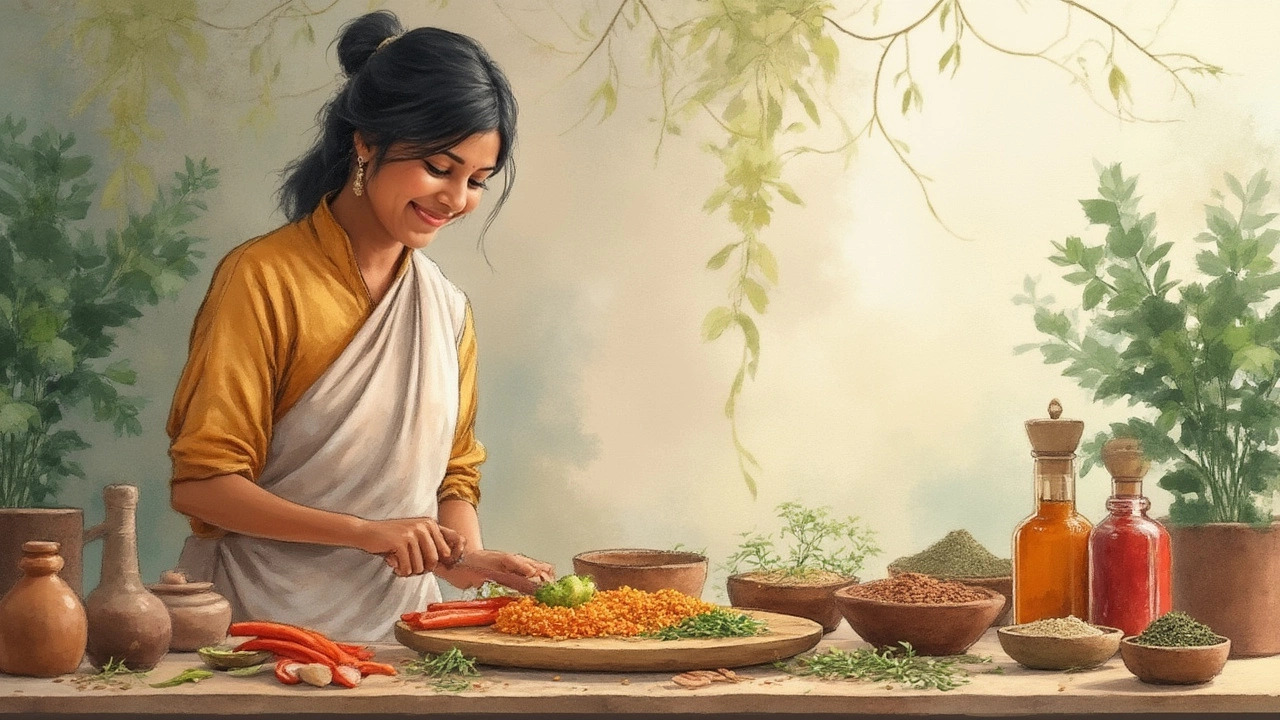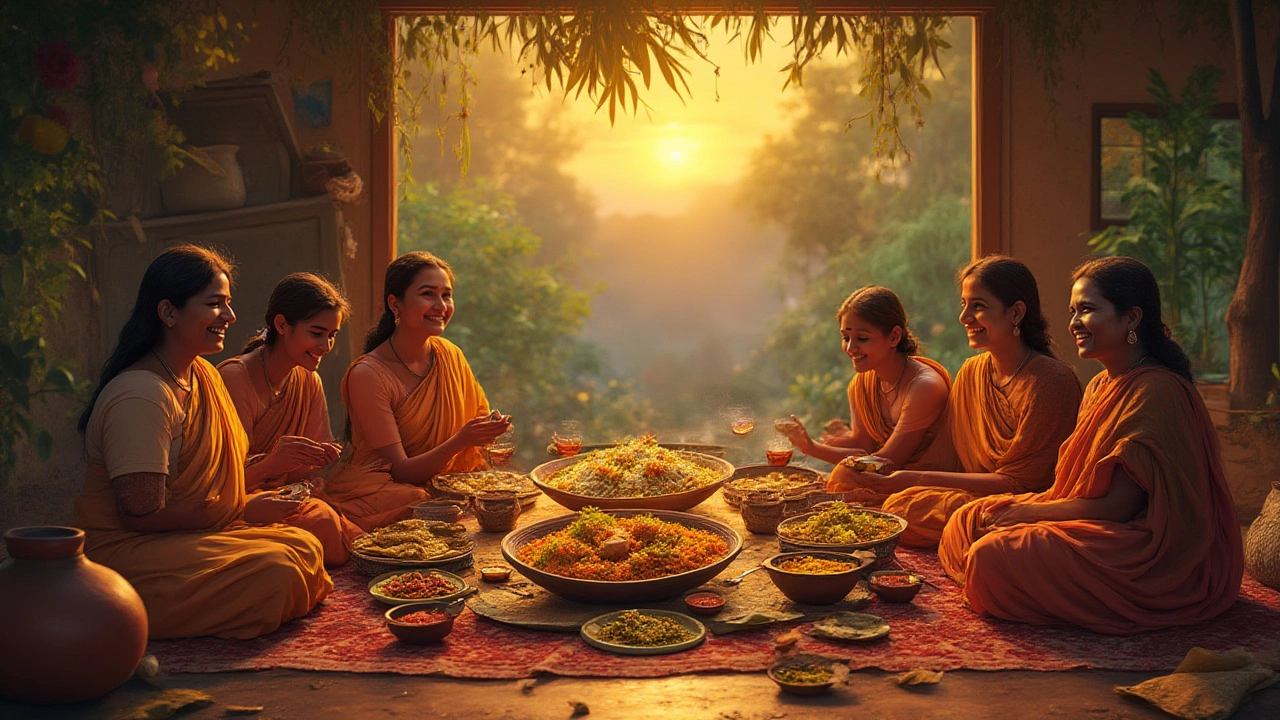Picture this: It’s late, you’re tired, but you’re also hungry. You rummage around the fridge and seriously consider that cold pizza or greasy takeout. Sound familiar? According to Ayurveda, this kind of late-night feast is a recipe for sluggish digestion, foggy mornings, and feeling heavy as a brick. But here’s a crazy fact you might not know—Ayurveda actually guides you to eat a light, warm, and nourishing dinner before the sun goes down. There’s science behind it too; research from the All India Institute of Medical Sciences found that eating early and lightly helps regulate blood sugar and sleep. So, what exactly does Ayurveda recommend for your last meal of the day?
The Basics: How Ayurveda Views Dinner
Ayurveda doesn’t just label foods as good or bad. It connects your meals with nature’s rhythms—your body’s clock isn’t that different from the sun’s schedule. In this traditional system, dinner should be your smallest main meal, ideally eaten before 8 pm. Why? Your digestive ‘fire’—agni—starts winding down at sunset, just like your energy. If you’ve ever felt stuffed and sleepy after a heavy nighttime meal, that’s your agni protesting. Instead, Ayurveda wants your dinner to be easy to digest, so you can actually rest at night instead of working overtime on digestion.
There’s this old rule of thumb in Ayurveda: Eat breakfast like a king, lunch like a prince, and dinner like a pauper. The logic is simple—the digestive fire peaks at midday and dims in the evening. That means your dinner shouldn’t look like a festival buffet. Interestingly, a Harvard study from 2021 showed that lighter evening meals can support better metabolism and deeper sleep, which echoes centuries-old Ayurvedic wisdom.
You’re probably wondering, "Okay, but what does a light Ayurvedic dinner look like?" Think simple, cooked foods with warm spices, seasonal vegetables, a small portion of grains or lentils, and gentle herbal teas. Raw salads or heavy meats at night? Ayurveda gives those a hard pass. The goal is to avoid anything that keeps your stomach busy long into the night. Everything revolves around being easy on your system.
What Goes into the Best Ayurvedic Dinner?
So, let’s break down what makes a good dinner, Ayurveda-style. First up—cooked foods. While raw salads are praised in modern diets, Ayurveda says skip the raw after dark. Your body digests cooked, warm meals way better in the evening. Examples? Stuff like khichdi—a super simple rice and mung dhal mix, mildly spiced and perfect for digestion. Throw in some sautéed seasonal veggies, and you’re golden.
Seasonal and local ingredients count big time. Their energies line up with what your body naturally needs at that time of year. For instance, in the heat of summer, try moong dal soup with zucchini or bottle gourd. When it’s cooler, hearty root veggies like sweet potatoes blend well in light stews. According to Ayurveda, using spices like cumin, fennel, ginger, and turmeric isn’t just about taste—they help stoke your sluggish nighttime digestion. Chef Ananda Sharma, who specializes in Ayurvedic cuisine, swears by these combo meals for people with slow digestion.
Portion control matters more than you might think. A good dinner shouldn't leave you stuffed. Ayurveda recommends filling only half your stomach with food, a quarter with fluids, and leaving the rest empty for air and movement. There’s actually a Sanskrit term for it: "mitahara." A light soup, some steamed veggies, and a spoon or two of rice does the trick. Overfilling your plate in the evening is linked in research to higher chances of acid reflux and restless sleep.
Don’t forget about the six Ayurvedic tastes—sweet, sour, salty, bitter, pungent, and astringent. Balanced meals hit most of these notes, often through the right combo of grains, pulses, and spiced veggies. For flavor and function, a little ginger tea with cumin can make digestion smoother. Want ideas? Here’s a traditional Ayurvedic dinner menu for a typical Indian family:
- Moong dal khichdi (rice and mung bean porridge) with turmeric and cumin
- Steamed carrots, zucchini, and spinach sautéed with fennel and black pepper
- Light fresh pickle made with ginger and lemon (skip the heavy oil)
- A cup of warm cumin-coriander-fennel tea after the meal
Not a fan of Indian flavors? No worries. Adapt the same principles—warm, soft, lightly spiced, not too greasy. For Western dinners, a small bowl of barley-vegetable soup, a side of steamed greens, and baked sweet potato fit right in. The idea is not what you eat, but how easy it is on your stomach.

Tuning Dinner for Your Body Type: Vata, Pitta, Kapha
Now, here’s where Ayurveda gets super personal. Not everyone has the same type of digestion. Your body type—called ‘dosha’ in Ayurveda—actually shapes how you should eat at night. There are three main doshas: Vata, Pitta, and Kapha. Each one needs a slightly different approach.
For the airy, quick-to-get-cold Vata type, focus on warm and moist foods. Vata folks do best with oily veggie stews, moist grains like rice or oats, and a little extra ghee or olive oil. Spices like ginger, fenugreek, and cardamom help keep things running smoothly. Cold food before bed? It’s a Vata nightmare. Instead, try a mild carrot-ginger soup or a creamy rice porridge with cinnamon.
Hot, fiery Pitta types need a cooler touch at night. Avoid anything too spicy or sour. Pitta dinner should be light, not greasy, and packed with mild veggies like zucchini, asparagus, or pumpkin. A bowl of basmati rice with steamed vegetables, coriander chutney, and a hint of fresh mint cools them right down. Skip late-night fried foods or heavy meats—they only add fuel to Pitta’s fire.
Kapha folks, on the other hand, are prone to sluggishness and weight gain. For them, dinner should be the lightest meal, and skipping it once in a while isn’t a crime. Go for spicy veggie soups, roasted cauliflower, or a little millet upma with asparagus and peas. Kapha should steer clear of dairy, oils, and sweets after sunset. Ginger, pepper, and dry-roasting spices in dishes can spark up their slow-moving digestion.
Confused about your type? Most clinics in India now offer quick dosha assessments. Or you can use trusted online tests from sources like Dr. Vasant Lad’s Ayurvedic Institute, which are scarily accurate.
Here’s a table to give you a sense of which foods to focus on—or ditch—based on your dosha:
| Dosha | Recommended Dinner Foods | Foods to Avoid |
|---|---|---|
| Vata | Warm stews, rice, oats, ghee, root veggies | Raw salads, cold drinks, dry snacks |
| Pitta | Cool grains, steamed veggies, mint, coriander | Spicy, sour, fried or salty foods |
| Kapha | Spicy soups, roasted veggies, light grains | Dairy, sweets, heavy grains, fried foods |
Practical Ayurvedic Dinner Habits for Modern Life
Life is busy, and let’s be real—a made-from-scratch khichdi every night is not always in the cards. But there are some totally doable Ayurvedic habits you can slip into any nighttime routine without much fuss.
Start with meal timing. Ayurveda suggests dinner should happen before 8 pm, but the earlier, the better. If you work late, just aim for at least two hours before bedtime. This gives your digestive fire a fighting chance. Studies published in the Journal of Clinical Sleep Medicine show that people who eat two or more hours before bed report fewer sleep problems and less heartburn.
Next, think about portions. Plates don’t need to be overflowing. Try using smaller dishes—researchers at Cornell found that people who swapped out large dinner plates for smaller ones ate up to 22% less without even realizing it.
If you like sipping something after dinner, trade sweet desserts or cold drinks for herbal teas. CCF tea (cumin, coriander, and fennel) is a classic Ayurvedic recipe. Just boil one teaspoon of each spice in two cups of water for ten minutes, strain, and drink. It tastes herbal (not weirdly spicy), and people swear it helps prevent bloating and heaviness.
Make the environment calm. Ayurveda doesn’t want you eating in front of your phone or the TV. Bright lights, loud music, or tense conversations can mess with your digestion. Dim the lights, play some soft music, and focus on the food. Your body will thank you.
Finally, don’t skip movement. Ayurveda encourages a gentle post-dinner stroll—even five or ten minutes of slow walking signals your body to start digesting. Modern science catches up here too: data from Japanese health researchers shows that post-meal walking can cut blood sugar spikes by up to 25%. You don’t need to turn into a marathoner, just a walk around your home or down your street does wonders.
So, what’s the ultimate Ayurvedic dinner? It’s one that’s warm, easy to digest, tailored to your body, served at the right time, and enjoyed in a peaceful setting. Not flashy, not complicated—just food that helps your body rest, rebuild, and recharge for whatever tomorrow throws your way.





